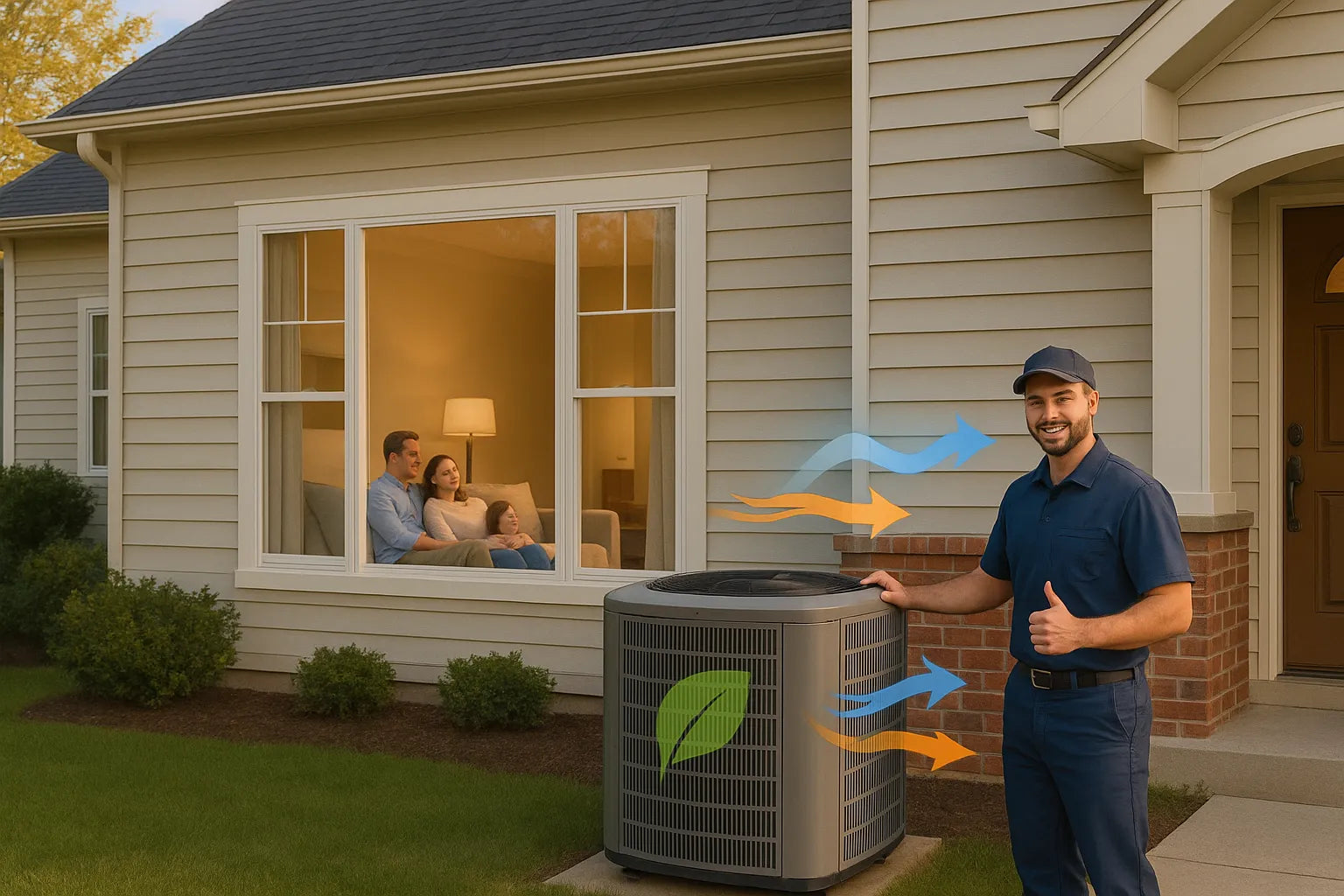A Saturday Surprise: Why Comfort Still Feels Off
Your new system should cycle in quiet, steady bursts. When it roars on and off or runs nonstop, size, not brand, is the usual villain. Oversized units “short-cycle,” blasting cold air, shutting down, and leaving sticky humidity behind. Undersized ones grind away all afternoon yet never catch up. In both cases, you burn energy, shorten equipment life, and stare at uneven room temps.
The moral? Right-sizing is not a luxury; it’s basic HVAC hygiene backed by every certified tech in our Help Center.
HVAC Sizing 101: What “Size” Really Means
Size equals capacity, measured in BTUs per hour. Think of BTUs as small packets of heat your equipment can move. A three-ton air conditioner moves about 36,000 BTU/hr. Match that capacity to your home’s heat gain and loss, and you get smooth cycling plus trimmed utility bills. Miss the mark, and comfort, cost, and component wear spiral. That’s why our Design Center crunches numbers before recommending a single part, whether it’s a R-32 condenser or a full dual-fuel packaged unit.
How Pros Calculate Load: Manual J in Plain English
“Manual J” sounds intimidating, but it’s just a methodical checklist: square footage, insulation R-values, window orientation, duct losses, and even how many people live at home. Software converts those factors into a precise BTU target. ACCA, which publishes Manual J, warns against rule-of-thumb guesses.
At The Furnace Outlet, our techs run Manual J for every package unit order, no extra charge, so you’re not gambling with thousands of dollars.
The Dangers of Going Too Big
|
Symptom |
Oversized Unit Impact |
Cost Hit |
|
Short cycling |
30 % more starts per hour |
Higher energy use |
|
Poor humidity |
Clammy rooms |
Mold risk |
|
Part wear |
Compressor stress |
Expensive repairs |
An oversized system blasts comfort in minutes, then shuts off. Rooms cool unevenly, humidity lingers, and parts hammer on and off until they fail. Research from ENERGY STAR shows short cycling can add 15 % to annual cooling costs. That’s cash better spent on upgraded filters or smart thermostats, both available in our accessories aisle.
The Pain of a System That’s Too Small
Undersized equipment feels like a car stuck in second gear lots of noise, no finish line. It runs constantly, skyrockets your electric bill, and still misses the setpoint on the hottest days. According to the U.S. Department of Energy, long runtimes can double compressor wear. You’ll call for repairs sooner, and warranties may not cover the strain. Before replacing, ask our support team if a ductless mini-split upgrade can supplement the load at wholesale cost.
Right-Sized Systems Boost Comfort and Cut Bills
Hit the sweet spot and magic happens: steady cycling removes humidity, temperatures hold within a degree, and energy bills drop up to 20 %. Even filter life improves because air velocity stays within design specs. Customers who pair a right-sized heat pump with our R-32 air handler systems report quieter rooms and reduced service calls. Add free shipping and our lowest-price guarantee, and the math gets even brighter.
Key Home Factors You Can Check Yourself
Before you schedule a load calc, grab a notepad:
-
Square footage (conditioned space only).
-
Window count and direction—south-facing glass adds major gains.
-
Attic insulation depth: aim for R-38 or better.
-
Ceiling height—vaulted ceilings inflate BTUs.
-
Occupant count and common appliance heat (stoves, servers).
Share these numbers with our live chat, and we’ll model a solution, whether that’s a right-sized through-the-wall AC or a commercial rooftop unit.
When Bigger Isn’t Better: Myths Busted
“I’ll just buy an extra-ton unit for insurance.”
Reality: You insure drafts, mold, and higher power bills.
“Smaller rooms don’t matter; the main zone drives size.”
Reality: Every cubic foot influences load. Oversizing for one zone wrecks balance elsewhere.
“Add square footage, multiply by 25 BTU, done.”
That shortcut ignores insulation, windows, and climate. Even ASHRAE cautions against fixed multipliers. Trust data, not folklore.
DIY vs. Pro Load Calculations: Tools, Limits, Costs
Free online calculators give ballpark BTUs. They’re fine for window units, but whole-home systems deserve professional input. Expect to pay $100–$300 for a Manual J from a local engineer often waived when you order equipment through The Furnace Outlet. Our advisors use ACCA-certified software and confirm duct sizing too. If you like to tinker, try an airflow hood or portable hygrometer to spot-check results.
Buying Smart at Wholesale
Because we sell direct, you get contractor-level pricing on everything from R-32 heat pumps to hotel PTACs with fast, free shipping. Not sure which bundle fits? Our licensed techs jump on the phone or chat in minutes and often suggest low-cost fixes before a total replacement. That honesty saves you cash and builds the trust we’re known for.
FAQs: Quick Answers Homeowners Keep Asking
Q: How often should I redo a load calculation?
Every major remodel or insulation upgrade warrants a fresh Manual J.
Q: Do smart thermostats fix short cycling?
They help, but only a properly sized system stops rapid cycling at the source.
Q: Can I oversize a heat pump for heating and use staging to tame cooling?
Yes—with inverter technology. Check specs or call our team before ordering a dual-fuel packaged system.
Ready to banish hot spots and trim energy bills? Gather your home data, visit our Design Center, or call the number atop our contact page. We’ll run a Manual J, size your gear, and ship it free, usually same day. With honest advice, wholesale pricing, and techs who pick up the phone, The Furnace Outlet makes right-sizing simple.







